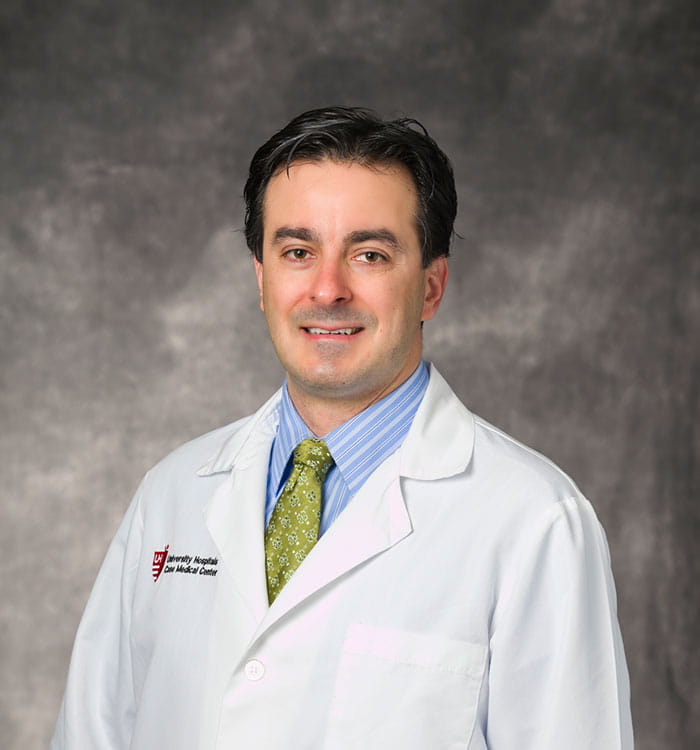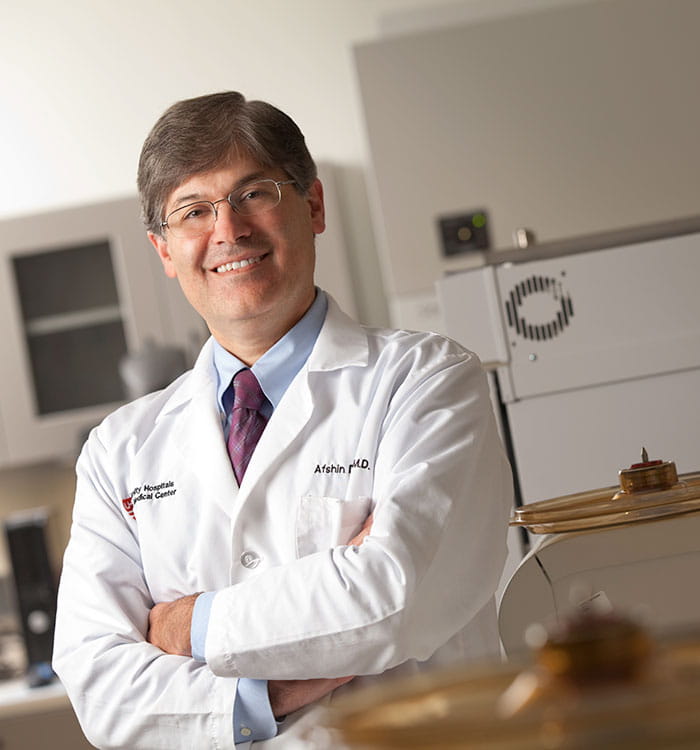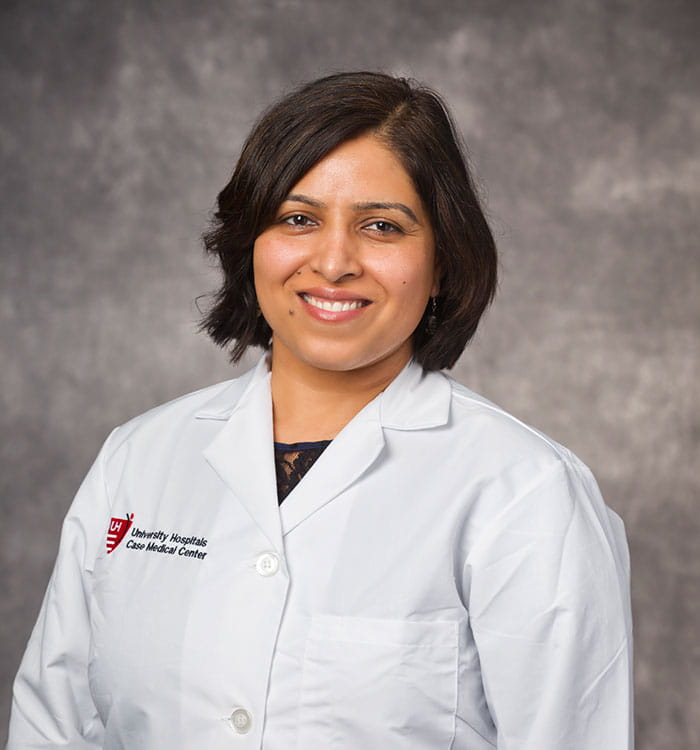Genomics for the Next Generation
January 01, 2016
New approach at UH Seidman Cancer Center simplifies testing, integrates genomics information with other complex tests
Innovations in Cancer - Winter 2016 Download PDF
 Joseph Willis, MD
Joseph Willis, MD Christopher Hoimes, MD
Christopher Hoimes, MD Afshin Dowlati, MD
Afshin Dowlati, MD Shaveta Vinayak, MD
Shaveta Vinayak, MDGenomic profiling provides valuable information about the potential molecular vulnerabilities of a particular cancer. However, even inexperienced hands, it can be unwieldy and slow.
“Up to this point, technologies haven’t allowed us to analyze more than a couple of genes per tumor sample,” says Joseph Willis, MD, Division Chief of Clinical Pathology at University Hospitals Case Medical Center. “We needed a platform where we could use just a small amount of tumor DNA and get a large amount of information.”
Such a system is now in place at UH Seidman Cancer Center. Developed in conjunction with the Department of Pathology at UH Case Medical Center and Case Western Reserve University, the new “hotspot” panel tests can identify mutations in up to 50 genes at a time, using a single tumor specimen.
“We’ve initiated this at UH Seidman for colon cancer, gastrointestinal stromal tumor, melanoma, uveal melanoma and acute myeloid leukemia,” Dr. Willis says. “Our intent is to continue to roll this out for other tumors.
“The idea is to identify more molecular targets than we were previously able to do with one specimen,” Dr. Willis adds. “But it’s more than that. There are other different platforms that can be used in synergy with these tests, such as fluorescent in-situ hybridization (FISH). The idea is to use these other ancillary tests in tandem with the next-gen sequencing to come up with a better profile of the tumor. This will help us better predict how the patient is going to do and identify different therapies that the patient may be able to use.”
Patients at UH Seidman Cancer Center who have stage 4 disease may undergo genomic testing, typically after one line of standard therapy. These results are reviewed by a Genomics Tumor Board, which makes recommendations. The breast cancer group within UH Seidman Cancer Center also has a dedicated genomics tumor board.
“Several medical oncologists, as well as geneticists, pathologists and other tumor board registrars, are present and we discuss the best opportunities for targeting the cancer,” says genitourinary medical oncologist Christopher Hoimes, DO, Chair of the UH Seidman Genomics Tumor Board.
“There are many alterations in cancer. It takes a genomics tumor board to distinguish the driver mutations and those that can be acted upon with molecular therapy. A mutation may occur, but it may not be the linchpin driving the process.”
Patients who have cancers known to be responsive to molecularly targeted drugs also undergo routine genomic testing. Lung cancer patients, for example, get genomics “when they walk through the door,” Dr. Hoimes says.
“Genomics has more implications in lung cancer than in any other cancer at this point,” adds Afshin Dowlati, MD, Director, Thoracic Oncology Program at UH Seidman Cancer Center. “There isn’t another disease that’s even halfway there in terms of targeted therapies. There are at least six to eight genomic abnormalities in non-small cell lung cancer. Non-small cell lung cancer comprises 90 percent of all lung cancer, and these genomic abnormalities affect 20 to 25 percent of patients. We have specific targeted therapies against these mutations, either available now or through clinical trials, so it’s relatively huge.”
Genomics also plays a critical role in the care of UH Seidman Cancer Center patients with breast cancer. Patients who have early-stage, hormone-receptor-positive disease undergo genomic testing to predict their need for and response to chemotherapy.
“This test includes an analysis of 21 different genes and provides a composite score of how overproduced or underproduced expression of these genes is,” says UH Seidman Cancer Center breast cancer specialist Shaveta Vinayak, MD. “For women shown to be at high risk, their treatments include chemotherapy and hormone therapy. The low-risk women can be
spared chemotherapy.”
Like other patients with advanced disease, women with metastatic breast cancer also undergo genomic testing. Women with aggressive triple-negative breast cancer typically are tested after just one line of chemotherapy, Dr. Vinayak says.
“We look ahead to see whether there are targeted therapy options for those patients,” she says. “The test reveals the DNA changes in the tumor, we get those results back and discuss them in our Breast Genomics Tumor Board.”
In addition to integrating genomics into clinical care, the team at UH Seidman Cancer Center is also involved in both basic science to understand tumor behavior and the more applied area of early drug development.
UH pathologist Dr. Willis is a member of the team that discovered the unique genomic signature of colon cancer among African-Americans, published in the Proceedings of the National Academy of Sciences. At the same time, breast cancer specialist Dr. Vinayak is pursuing the overlapping molecular irregularities between triple-negative breast cancer and breast cancer caused by the BRCA mutations.
“Understanding the biology of triple-negative breast cancer and BRCA1- and BRCA2-mutant breast cancer allows for improved therapeutic strategies that target the DNA repair defects of these tumors,” she says. “Trials with treatment selection based on tumor DNA repair capacity in triple- negative breast cancer are currently in development and may lead to improved long-term outcomes.”
On the drug development side, Gries Endowed Director for the Center for Cancer Drug Development, Dr. Dowlati and his team have mined genomic and drug-sensitivity data in the Cancer Cell Line Encyclopedia and Cancer Genome Project to identify new therapeutic agents for small cell lung cancer (SCLC).
“There are currently no molecular, targeted approaches to treat SCLC, similar to those used successfully against non- small cell lung cancer,” Dr. Dowlati says. “We’ve identified heat shock proteins, cyclin-dependent kinases and polo-like kinases (PLK) as attractive molecular targets. Using PLK inhibitors as an example, we identified and validated a gene signature for drug sensitivity in SCLC cell lines. This gene signature could distinguish subpopulations among human SCLC tumors, making it very useful clinically.”
For his part, genitourinary medical oncologist Dr. Hoimes is capitalizing on the fact that cancer may be treated based on genomics as opposed to site of origin. Genomic alterations are seen across many different types of cancer, and using a precision medicine approach to treat these patients based on their tumor’s genomics while on a clinical trial is showing promise. Dr. Hoimes is also exploring how genomics information can inform host anti-tumor immune responses with potential to use more sophisticated agents such as anti- cancer vaccines, checkpoint immunotherapy and adoptive cell therapy.
“We’re starting to break down the idea that cancer is relegated to any particular histology or tumor type or organ type,” he says. “At least for some cancers, there may be crossover. We currently have a handful of ‘basket trials’ using molecular targeting agents in patients with specific mutations found in their tumor and agnostic to the cancer site of origin. The broadest basket is the NCI Molecular Analysis for therapeutic choice (match) trial at Case Comprehensive Cancer Center. As PI of the NCI MATCH study at UH Seidman Cancer Center, we’re looking for patients who have genomic alterations and matching them to a drug that can potentially interrupt the genomic driver alteration. This is the largest effort that we’ve had for understanding the landscape of genomic alterations in tumors, as well as ability to impact patients’ disease course. Because the tumor site of origin is not a factor, this trial has really broadened the population of patients able to be considered for a trial and has been especially exciting for those with rare cancers.”
For more information on genomics at UH Seidman Cancer Center, email Christopher.Hoimes@UHhospitals.org.
Tags:


